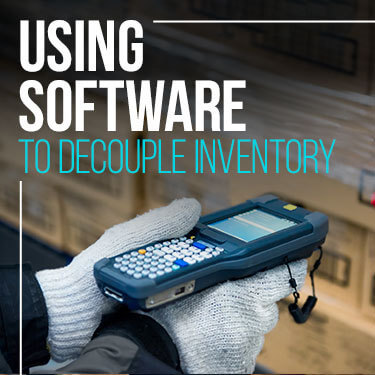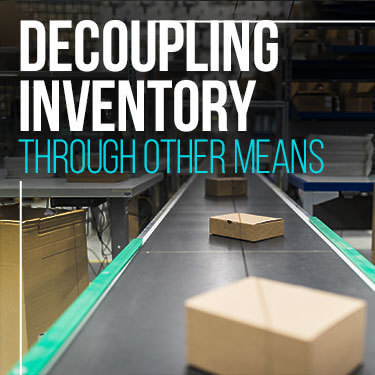
 Copy URL to Clipboard
Copy URL to Clipboard
Decoupling inventory is one of the top reasons that the flow of goods in today’s consumer market is so consistent. When a manufacturer decouples their inventory, it ensures the speed and reliability of completed products on time and in a manner that keeps the supply chain moving. Keeping the supply chain moving is what drives commerce around the world to meet the needs of businesses and consumers.
A decoupled inventory is the stock of extra materials at each phase of production in a manufacturer's inventory. If a particular station in the production phase is slow or has broken down, then the decoupled inventory can supplant the breakdown. This inventory keeps the supply chain moving and minimizes the risk of stockouts.
In this article, we explain what a decoupled inventory is and how it functions and relates to other inventory forms in a supply chain.

When decoupling inventory works, it occurs from a buffer stock of extra inventory that will move in to subsidize the customer demand due to issues that stem from internal problems within an inventory. The inventory set used by decoupling is the safety stock levels that have been established to prevent an internal stockout.
The direct purpose of decoupling serves as a buffer for the manufacturer to avoid any issues during assembly. If a problem arises in the manufacturing process due to an internal stockout of raw material, production is halted, and disruption in distribution and the supply chain occurs.
In a production line, a decoupled inventory is a small inventory withheld from sale to serve as a wedge between any breakdowns in the supply chain. If a machine breaks, for example, this inventory can supplant any delays in manufactured goods that fail to make their way into the supply chain.

To implement a decoupled inventory effectively, you need to keep a backup stock of components that make up a product. The backup inventory of parts and materials will protect that station against a breakdown or slow build time at every production point in the manufacturing process.
The purpose of decoupling an inventory is so that no one station during the build process is waiting on another. In a sense, there is perfect harmony and balance in the production flow. This flow directly affects the supply chain and the flow of goods to the business, preventing stockouts from occurring.
One of the more critical terms when discussing decoupling is the “decoupling point.” This term refers to the point in either the supply chain or manufacturing that is critical to grouping a product or the component in a particular stage of production.
Protecting yourself as a business from any potential disconnects in your stock due to supply and demand is critical. You will need to have a more extensive held inventory as a business, creating a “higher held cost” of inventory but preventing a stockout.
Maintaining an adequate inventory while sustaining levels that can meet or exceed demand is a crucial component of a supply chain. Implementing a decoupled inventory substantially benefits fast and fluid production that makes its way to the supply chain. Breakdowns in the supply chain can quickly be avoided as long as the practice of decoupling is deployed by the manufacturer.
There are many advantages and disadvantages to decoupling an inventory in the supply chain. Typically, the single greatest result of this form of inventory action is to prevent the breakdown in the supply chain, which can and will lead to stockouts. The only real disadvantage is the requirement of held capital to secure the safety net of a decoupled inventory.
There are several ways to explain how to decouple an inventory in manufacturing or assembly. The best way to illustrate this is to provide an example of the manufacturing process of a personal computer (PC). Creating a PC takes various internal components, and each one is critical to the result.
Each component used to create a PC is typically installed at different stations/stages in the production process. Carrying extra components for each stage of production will create a shield against any delays in building your PC.
The table below serves as an example to illustrate the build of 100 PCs, the components required for the build, and a potential example of decoupled components at each phase of the build process as it relates to constructing a PC and then shipping it through the supply chain.
| Part | 100 Ordered PC’s | Decoupled Components |
| Case | 100 | 50 |
| Motherboard | 100 | 50 |
| Power Supply | 100 | 50 |
| Memory | 200 | 100 |
| Hard Drive | 100 | 50 |
| Video Card | 100 | 50 |
The amount of decoupling required will vary depending on a wide array of factors. These factors are predetermined by gauging how various products move in and out through the supply chain and distribution.
Unfortunately, when carrying a decoupled inventory in manufacturing, you will effectively be carrying a larger held inventory of components -and with that comes a greater held cost. However, a manufacturing breakdown will come with a higher cost than holding a decoupled inventory, so the choice is yours.

For supply chains to manufacture and meet the ever-changing supply and demand landscape, advanced tools to meet expectations are required. Through the use of advanced software known as enterprise resource planning (ERP) and material requirements planning (MRP), the decision-making is streamlined.
When using real-time data software such as ERP and MRP, manufacturing can automate the various stages of production with ease. At the same time, the supply chain manages the daily operation and flow of their goods while supporting ample lead time.
The purpose behind the ERP system is to manage and plan the various stages of operations within your supply chain. The areas which benefit from ERP systems include operational and project management, human resources staffing, and financials.
Using ERP system applications effectively manages manufacturing, supply chain, and individual business needs globally. Some examples of ERP systems covered include the following:
The ERP system essentially streamlines the various stages of management in the supply chain. The advantages of this software system play out in the various points of systems integration, real-time operations, and accommodating demand in a unified management database.
This system is directly responsible for improving and maintaining productivity in the supply chain or business. In manufacturing, an MRP system is deployed to help facilitate the planning of raw materials scheduling.
Some key advantages of deploying an MRP system will affect the following stages of the supply chain or manufacturing process:
Within an MRP system, other processes like estimating demand, validating resources related to the demand, and process monitoring prove critical to the success or failure of the supply chain or manufacturer. Using a software system like MRP can help save time and money and prevent the potential disruption plaguing your business.

When decoupling the inventory of a manufacturing business or the supply chain, there are several key terms to look at that impact your type of inventory. Also, at the very heart of decoupling an inventory is calculating your inventory days on hand.
By calculating your inventory days on hand, any supply chain or manufacturer is equipped with the knowledge of the flow of finished goods versus the demand and what is needed to maintain the pace without running into financial risks.
Complete and total inventory management is required to maintain a good workflow and revenue stream. The various forms of “cushion stock” you can implement in your business will help you navigate any disruption that may occur in fulfillment.
The safety stock that is part of an active inventory provides a cushion to the supply chain or warehouse in the event of disruption through breakdown or high consumer demand. This stock serves to supplant any breakdowns and delays.
The absolute best implementation of safety stock is done in conjunction with reorder point ordering. Using the formulas found here regarding how to calculate safety stock, you will be able to minimize the cost of holding extra stock while preventing a stockout at the same time.
This form of inventory is consistently part of the working inventory. Everyday inventory demands are facilitated by constant supply and demand rotation of an active inventory. The turnover rate of an inventory is a large part of active cycle stock.
The management of cycle stock helps avoid stockouts, high overstocking, low levels, and fast turnover of any safety stock. Also, this stock improves the cash flow capital of your business or supply chain.
Whenever goods have been purchased and distribution occurs, that inventory is considered in the “pipeline.” A pipeline inventory explicitly means the portion of supply chain goods in transit and have not reached their delivery destination.
The pipeline is the connection between the business and the supplier. When the pipeline inventory has not arrived and is still en route, it is allocated as part of the internal inventory.
Any business that applies a minimal or simplified approach to conducting its business is a lean organization. Decoupling in lean business functions similarly to a more significant and widespread company, just on a smaller and more efficient scale.
When decoupling to a lean organization, we must first identify what this is. For example, a lean organization can come in the form of a tire repair shop. This organization's primary focus is to provide value while reducing inventory waste.
The whole point of reducing waste through a lean organization comes from lowering the necessary capital required for acquiring and maintaining an active inventory in the business. Also, while carrying a reduced inventory, there is less emphasis on tying up additional money for other resources.

When one looks at the nature of decoupling inventory as a benefit and how it impacts the supply chain, the answer is quite apparent. We talked about how the various inventories like cycle stock, safety stock, and pipeline stock function.
These forms of stock all play an intricate role in the supply chain and dictate how an unknown issue arises, or a breakdown in the supply chain can be averted. It is critical for any business to keep the flow of goods moving; otherwise, one risks the loss of profits and building consumer relationships.
A decoupled inventory will ensure that the pace of produced goods is manufactured without disrupting the supply chain due to a breakdown in manufacturing. This strategy ensures that every business has adequate cycle stock to turn over. In the event of increased demand for an item or if a decoupled inventory somehow fails, the safety stock then supplants any disruption.
So you see, a decoupled inventory is the root of everything in the manufacturing process as products make their way into the supply chain. The best way to look at decoupled inventory is an insurance policy to keep the flow of goods moving.
In today's business world, time is everything. With the shift from brick and mortar to eCommerce business, the need for a trusted third-party logistics (3PL) partner is in high demand. R+L Global Logistics offers a wide array of strategies and services that are not only cutting-edge but are reliable.
Our team is ready and eager to streamline your business while deploying the best methods to empower you to succeed. R+L Global Logistics fulfillment and distribution services are industry-leading and are guaranteed to meet and exceed your expectations.
We have a friendly and knowledgeable staff ready and waiting to assist you in any of your logistical challenges. Feel free to give us a call at (866) 989-3082 or get a quote direct. Also, we do have a live chat support option available in the bottom right corner of the page. R+L Global Logistics is committed to the success of your business; we are just one call or click away.
